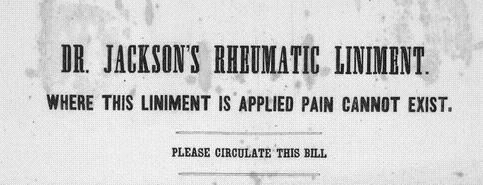Food and Drugs
If you like quackery as much as I do, you harbor resentment toward the Food and Drug Administration for extinguishing the exciting world of 19th century patent medicine in the United States.

Before muckraking journalists and regulatory crusaders ruined things for everbody, anybody with a kitchen sink and some industrial solvents could start a drug company. Reputable pharmacists and traveling hucksters alike marketed fantastic pills supposedly capable of curing any number of unrelated ailments. (Visit this site featuring old patent medicine ads, or the large Library of Congress archive of advertising for much more.) Just about everything you could get over the counter was laced with (if not entirely consisting of) hard drugs--- morphine, heroin, opium. Hell, Coca-Cola even really had cocaine in it. Good times.
The main joy I find in quackery is attempting to sort out the twisted logic of the quack, over a century later, with all the ensuing complications. It's often difficult to tell if a malady described in a quack pamphlet is a precise ailment we now know by a different name (eg "consumption" = "tuberculosis"), a vague description of symptoms reflecting the scientific ignorance of the time ("dropsy," "biliousness"), or merely a medical-sounding label arbitrarily draped upon something seriously bad ("softening of the brain"). A fun question to ponder is often "to what extent did this quack know he was a quack?"
As a tiny example, let me excerpt from a densely packed ten-page pamphlet for Dr. L. Q. C. Wishart's Pine Tar Cordial. Wishart begins his pamphlet with a dramatic narrative detailing (in florid fashion) the barbaric nature of 19th century medicine.
HELP! HELP!! HELP!!! HELP!!!! Hear their bitter cries, borne on every breeze. It is the voice of your sick mother, your dying father or perishing children; their bodies are suffering the burning hell fires of poisonous doses. Calomel, Antimony, Copper, Zinc, Arsenic, Arsenious Acid, Stramonium, Foxglove, Morphia, Belladonna, Henbane, Opium, Nux Vomica, and Narcotine. See the dim lamp of life as it flickers. Nature stands up to the fight as a tried warrior, and commands his soldiers to come up to the struggle. The Stomach answers, "I have received a ball of arsenic from the doctor's gun; it was his last shot; it has dissolved itself within me; it feels like liquid fire; every avenue through which gastric juice would flow, is obstructed by inflammation from the dreadful charge." "Come Liver I can depend on you to send life, and blood, and vitality to every part of the system." The Liver answers, "I knew the victory of the day depended upon my effort, although I was very sick, and salivated by the last dose I received, yet when I saw my kindred, the nerves--that I had fed for years, trembling and fainting for the want of pure food, I rallied myself to unlock the store-house of pure blood, and just at that moment I received a bombshell from death's gun; it was charged with a dose of Calomel; and my rich blood was turned to burning water. I can give no assistance for I am myself slaughtered by poison." "O! Lungs do not thou fail in this day of battle, or a great man will perish, and go down to the grave. Do you not see him? He is gasping, he is gasping for breath. Come! oh come quickly, or all is lost." The Lungs answers, "I can do nothing for I have been contracted for the last five days. Every air passage within me has been poisoned, and the mucous lining taken off, leaving me no vitality to act upon. I am chained to the car of death by that dread enemy Antimony."
(It doesn't end there; it goes on like that. For ten pages. I presume opium was involved.)
All drama aside, this is a rather perceptive critique. But then you've got the rest of the pamphlet, where all of these ill-advised treatments are contrasted with Wishart's miraculous cure-all "Pine Tar Cordial." Adorable, isn't it?
But we should not take the FDA for granted: the Gilded Age had a dark side. Quackery had consequences and we now turn to them.
In the days before antibiotics, various metal solutions were in common use as disinfectants and purifiers. There is reality behind it: various metals and metal solutions do an excellent job of killing bacteria. A small amount of colloidal silver, for example, will keep drinking water drinkable for long periods of time.
By this point the quack in you is probably wondering: "What would a large amount of colloidal silver do?"
It would turn you blue. Permanently. I shit you not.

The silver just goes somewhere deep in your skin and stays there forever. It's called argyria. Apparently there aren't many negative side effects, aside from looking like a fucking zombie. (Other heavy metals have corresponding permanent-skin-dye conditions, like gold (chrysiasis) and bismuth (bismuthia).)
As you may have guessed from the above photo, argyria is not a thing of the past. People still get it--- primarily because of a resurgence in the use of colloidal silver in "alternative" medicines available on the internet. Perhaps the most famous case is that of Stan Jones, a Libertarian from Montana who has run for various public offices in that state.

He argyrified himself through the overuse of homebrew colloidal silver. (True to libertarian form, he is not all that upset about it.)
- Login to post comments

Comments
ESAD
(and by that I mean: Eat Silver and Dye)
When you're done rubbing it on your gums...
... take care of those pesky flakes.
